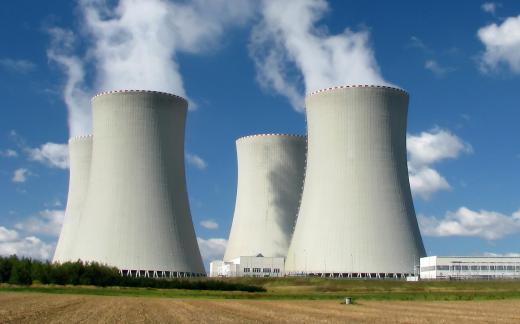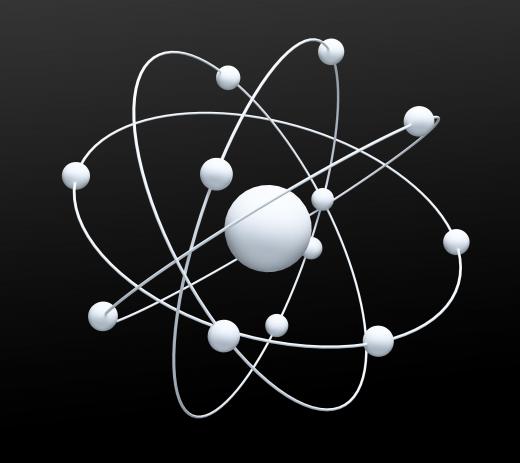What is a Nuclear Reaction?
A nuclear reaction is a process that occurs when the nucleus of an atom loses subatomic particles to the degree that its properties are altered. The original atom of an element that undergoes a nuclear reaction can either become a different isotope, or variety, of the same element or it can become a different element entirely. Nuclear reactions are closely related to radiation in general, which can occur spontaneously outside of a reaction. Radiation simply describes the process of energy or articles being emitted from an atom or other particle. The term nuclear reaction, however, usually specifically refers to a situation in which the nuclei of two atoms collide and alter the properties of at least one of the nuclei.
A nuclear reaction can occur in many different forms, each giving considerably different results. In a fission reaction, a large and often unstable particle, either spontaneously or as the result of a collision, splits apart into two different particles. The opposite occurs in a fusion nuclear reaction: two smaller particles collide and their nuclei combine to form a larger particle. Fusion reactions occur naturally in stars, but most human attempts to effectively and efficiently control them have failed. In a spallation reaction, a nucleus is struck with enough momentum to dislodge several neutrons or protons, thereby reducing the atomic weight of the particle.

Fission nuclear reactions are used in nuclear reactors to produce usable energy. Unstable particles collide and split apart, generating a significant amount of kinetic and thermal energy. This energy can be harvested by the nuclear reactor and put to use for human concerns. There is significant interest in the use of fusion reactions to generate power,as they tend to release a considerable amount of energy. Unfortunately, fusion reactions are extraordinarily difficult to control--they occur naturally in the high-pressure, high-energy conditions present on stars, and such conditions are very difficult to replicate.

There are several different kinds of particles that are commonly emitted from nuclei during a nuclear reaction. Alpha particles are essentially the same as the nuclei of helium atoms and are composed of two neutrons and two protons bound together. Beta particles are simply electrons; they have a much smaller mass and a negative charge. Neutrons are also released in nuclear reactions; they are very penetrating because they have a neutral charge so there are few forces that prevent them from passing through various substances, including human skin. Gamma rays are rays that leave the nucleus in the form of pure energy; they are also highly penetrating and can pass through almost anything because of their nonexistent mass and neutral charge.
AS FEATURED ON:
AS FEATURED ON:














Discussion Comments
@glasshouse: There are a number of different causes of meltdowns. What you described is a loss of coolant accident. This is the type of accident was part of the cause of the Three Mile Island partial meltdown. From what the news is reporting, this is also the cause of the Fukushimi reactor meltdowns in Japan.
I am not an expert in nuclear chemistry, so I am not sure exactly how it occurs, but power spikes in a nuclear reactor can also cause meltdowns. The Chernobyl meltdown was caused by human error that led to a power spike that damaged the reactor core.
Problems with pressure can also cause meltdowns of nuclear reactors. In these cases, coolant pressure drops thus reducing the heat transfer efficiency of the coolant. The result is the overheating of the fuel rods and a subsequent meltdown.
@fiorite- A nuclear meltdown occurs when the fuel rods in a nuclear power plant begins to melt. If the fuel rods are not cooled properly, they can melt through the reactor core and through the reactor housing. A partial meltdown occurs when the fuel rods begin to melt because of a catastrophic power failure. If the fuel rods heat up to more than 2000 degrees Fahrenheit, then the zirconium alloy around the fuel will begin to melt, exposing the superheated radioactive isotopes. This melting will result in the fuel rods melting through the reactor housing, exposing the plant to radiation.
If the fuel continues to melt, the radioactive fuel can melt through the outer reactor housing. This will cause radioactive materials to leak into the atmosphere, causing death in the near term and elevated levels of cancer in the long term.
What is a meltdown at a nuclear plant? How does the process work and what type of radiation does it eject into the atmosphere? How long does the radiation threat last?
Post your comments